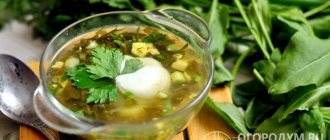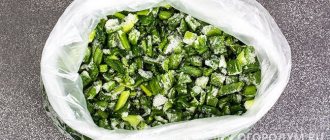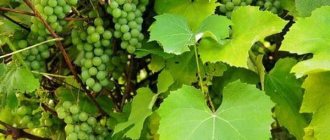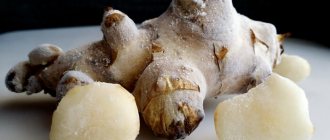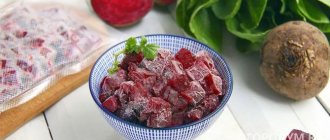Horseradish is one of the best natural antiseptics. It is used to prepare sauces, seasonings, snacks, pickled and salted vegetables, and cold soups. The product improves appetite, increases the body's defenses during epidemics of influenza and ARVI, is used in the treatment of sore throat, and alleviates gout, rheumatism, and kidney stones.
Freezing ensures the preservation of the beneficial properties of horseradish, improves the taste and eliminates the pungent odor of the root. In this article we will tell you how to freeze roots and leaves, how to properly store and use the preparations.
Is it possible to freeze horseradish for the winter?
Horseradish is the only plant that can withstand temperatures down to -90°C without losing its beneficial properties, so freezing it for the winter is not only possible, but also necessary. The advantage of this storage method is the loss of the pungent odor, which forces housewives to suffer in the process of grinding the roots on a grater. The second advantage of freezing a product is an increase in taste.
Horseradish is characterized by high nutritional value - the leaves and roots contain B vitamins, vitamin C, E, K and PP, potassium, calcium, sodium, magnesium, sulfur, phosphorus, iron, copper, fluorine, zinc.
Reference. 100 g of product contains 61.1% of the daily requirement of ascorbic acid.
Contraindications for use
No matter how useful horseradish may seem, not every body is able to perceive it normally. It is not recommended to eat it for those who have at least some problems with the intestines, digestive tract, etc. It is also not recommended to use horseradish for cosmetic purposes for those who have oily, dry or problematic skin. Even if the skin is perfectly healthy, you should not leave horseradish on your face for a long time - it can cause burns and damage to your facial skin.
Eating horseradish is contraindicated:
- Pregnant and breastfeeding women.
- People with individual intolerance to the product.
- People with acute intestinal and gastrointestinal disorders.
- With increased acidity in the body.
Selection and preparation of horseradish for freezing
Juicy roots without dark spots, damage and signs of rotting at the age of 2-3 years are suitable for freezing. The leaves should be fresh, green and crisp. When cut, the roots should be milky or white.
The roots are soaked in cold water for 1-2 hours to remove dirt and make cleaning easier. The washed roots are brushed and the skin is cut off with a sharp knife or vegetable peeler. To minimize exposure to air, place the peeled horseradish in a bowl of ice water. This will preserve the aromatic substances of the plant. Then the roots are dried with a paper or waffle towel and frozen.
Horseradish leaves are thoroughly washed under the tap, placed between two towels or dried in a salad and herb dehydrator to remove water.
The photo shows horseradish roots and leaves.
Pie
Useful preparations allow you to prepare a layer cake with frozen berries. There are many different recipes. For the simplest one, you will need 500 g of berries and the same amount of dough. You also need sugar (1/2 cup), starch (3 tbsp) and an egg. Puff pastry can be purchased ready-made. It must be divided into 2 parts. One of them needs to be rolled out to the size of a baking sheet. Grease the container with oil and transfer the dough.
The berries must be mixed with sugar and left for 15 minutes. Then you need to remove the liquid and add starch. Now you can add the filling. After this, we lay out the second rolled out layer on which to make cuts. The baked goods are treated with egg. Place the pie in the oven for 30 minutes, which must be preheated to 200 degrees. Do not immediately remove the cake from the mold, let it sit a little. The result is a delicious dessert that will be an excellent addition to any tea party.
Freezing methods
There are several methods of freezing, depending on the purpose of use in cooking. The roots are frozen whole, in pieces, or grated.
Entirely
Roots without peel are placed in plastic bags of 3-4 pieces. or wrapped in cling film. Then place it in the freezer compartment of the refrigerator.
Pieces
The peeled roots are cut into 2-3 cm pieces and placed in freezer bags or food containers. Thick bags with a zip lock are ideal - they do not allow air or foreign odors to pass through.
Containers are sealed with lids or wrapped in cling film. The preparations are placed in the freezer. After 3-4 hours, take out the workpiece and shake it - this way the pieces will not stick together into one mass.
This is interesting:
Features of pickling cucumbers for the winter in a barrel.
Recipes for canned watermelons for the winter without sterilization.
Grated
The method of storing grated horseradish is labor-intensive, but you will already have a ready-made component for preparing dishes. Peeled and soaked in cold water, horseradish is grated by hand on a fine grater or a more gentle method of grinding is used in a blender or meat grinder.
To protect the eyes and respiratory organs, wear a respirator, if available, or a cotton-gauze bandage, and construction glasses.
A plastic bag is pulled over the outlet of the meat grinder so that the chopped horseradish falls directly into it. Thus, it is possible to minimize the release of odorous vapors into the air.
Prepared horseradish is packaged in freezer bags or trays.
Advice. Mix chopped horseradish with grated apple and lemon juice. Use it as a snack or dressing.
Leaves
Prepared horseradish leaves are placed in bags whole or cut into strips. This preparation enriches the taste of meat dishes, soups, appetizers, and sandwiches.
How to defrost correctly
No pre-defrosting required. The roots are placed in a blender and ground, and then used, for example, to make a dressing or sauce. As for the foliage, it can be put in soup and boiled or stewed.
Sometimes it happens that the blender cannot cope with dry roots. Then you need to cut them smaller and add 2 tbsp. l. ketchup. If the horseradish is too large, you can let it sit for several hours at room temperature. However, you should not use a microwave or other methods of accelerated defrosting.
You can defrost root vegetables at room temperature.
Important! The product cannot be re-frozen. Therefore, it is important to take leaves and roots only in quantities that can realistically be consumed at one time.
When preparing horseradish, it is placed in small bags so as not to take a large batch at once.
Application
Horseradish is widely used in cooking for the preparation of:
- cold soups: botvinya, okroshka, mushroom, vegetable, borscht;
- gravy for meat and fish;
- sauces with sour cream, yogurt, mayonnaise with the addition of lingonberries, cranberries, dill, parsley;
- homemade alcoholic drinks (hrenovukha);
- savory appetizers for meat with tomatoes or beets;
- marinades, pickles;
- spicy salads.
A culinary masterpiece called “khrenovina”, “khrenoder” has long been loved by fans of savory snacks. Other names for this seasoning are “Ogonyok”, “Russian adjika”. The appetizer is prepared from tomatoes, garlic and horseradish root twisted in a meat grinder. The finished mixture is salted to taste, seasoned with vinegar, black or red ground pepper. The proportions are arbitrary, depending on the desired spiciness.
A spicy sauce is prepared with horseradish leaves.
For this recipe take:
- 300 g fresh or frozen horseradish leaves;
- 1 kg of tomatoes;
- 6-8 cloves of garlic;
- sugar and salt - to taste.
All components of the sauce are ground in a meat grinder and sugar and salt are added. The resulting mass is placed in clean 250 ml jars and placed in the refrigerator for storage for three months.
Healing properties of foliage: top 14
Biologically active substances found in plant tissues are used as a preservative for winter home preparations.
When preparing canned food, you can add not only fresh, but also dried leaves.
The plant has a spicy taste due to the essential oil included in its composition. It persists even when the leaves are dry.
Consider the use of the medicinal properties of horseradish leaves:
- They have a detrimental effect on microorganisms. It is not for nothing that the plant is ranked among natural antibiotics. In ancient times, the foliage was used as an antiseptic.
- External compresses are often made from horseradish leaves to help relieve inflammation. Internal use of the leaves will also help relieve inflammation. For diseases of the oral cavity, rinsing from the leaves will serve as an effective pain reliever and antiseptic.
- The plant helps the body get rid of toxins and harmful elements. The unique composition of the leaves helps cleanse the body. When unwanted salts appear and are deposited in the body, a leaf-based tincture will help remove them. Few people know, but horseradish leaves also cleanse the body of toxic toxins. Alcohol tincture of leaves with long-term use significantly reduces joint pain. Regular consumption of horseradish can promote the regeneration of cartilage tissue.
- The micro- and macroelements contained in the plant normalize the functioning of the stomach. If there is a lack of gastric juice, then horseradish leaves will help replenish it. They will restore the functioning of the digestive system and normalize the functioning of the gastrointestinal tract. It is also worth noting that the product is low-calorie, so it will definitely not add extra pounds.
- Among the healing qualities of the foliage, it is worth noting the relief of respiratory diseases. It is not without reason that the plant has established itself as a natural mucolytic. And rinsing with leaves speeds up the healing process of the upper respiratory tract many times over. Take a mixture of leaves and honey orally for a severe cough. And the condition of sinusitis will improve by using an alcohol tincture.
- The foliage strengthens joints and helps restore muscle tissue. The plant has long been used for osteochondrosis as a pain reliever, relieving inflammation. They use both medicinal baths from the leaves and in the form of compresses, placing them on the painful area. The result is relief from muscle pain.
- Among the properties of foliage, it is worth noting that it increases immunity. In the autumn-winter season, when cold viruses are in the air, the plant helps the body fight bacteria and viruses. Many people even use it as a preventive measure against diseases. Horseradish leaves also saturate our body with various vitamins and additional energy, which is so important during autumn and winter.
- Infusions and decoctions can remove excess fluid from the body. Horseradish leaves have long been used with great success as a diuretic. Therefore, for pathologies of the kidney stones and genitourinary system, these remedies and preparations based on leaves are used with great success.
- By adding leaves to your diet, you can strengthen your heart and blood vessels. The plant maintains the tone of the heart muscle. The foliage is successfully used for hypertension and anemia.
- The plant acts as a medicinal substance on liver cells. Protects and helps maintain the health of this important organ for us. And hepatitis can be successfully treated with a tincture adding honey and lemon to the leaves.
- Foliage has a restorative effect on the body of women. Decoctions and infusions restore the menstrual cycle.
- This plant is also used to strengthen the male genitourinary system. Use helps increase male strength. Used along with therapeutic treatment in the fight against prostatitis.
- The infusion is indispensable for improving the health of the oral cavity. The juice obtained from horseradish leaves can relieve even severe toothache. The plant is used as a disinfectant for stomatitis.
- Who would have thought, but horseradish leaves are used in cosmetology. They successfully regulate sebum secretion in the scalp. Thanks to its rich composition, the leaves maintain the beauty of the hair and also strengthen the nail plate. Women suffer when their hair begins to fall out. The beneficial substances that are part of the foliage help combat this problem.
In addition to what is described above, this “horseradish” plant successfully relieves headaches and also helps relieve inflammation in ear disease.
Since the sugar content in the leaves is low, diabetics can also add them to their diet within reasonable limits.
People who are overweight using horseradish leaves will be able to lose kilos by accelerating the metabolic process.
